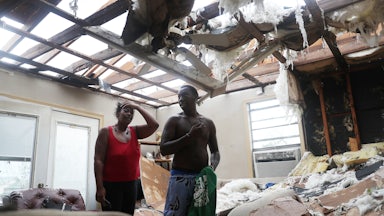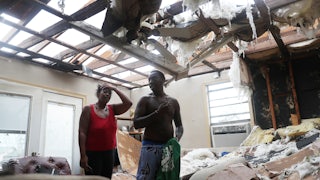As Hurricane Ian approached the coast of Florida, private jet flights out of Tampa—the biggest city in the storm’s direct path—increased by 71 percent, carting wealthy Florida residents off to second, third, or fourth homes on the island of Nantucket and in Aspen, Colorado. The Lee County Sheriff’s Office, meanwhile, refused to evacuate the residents of a 457-bed jail in downtown Fort Myers, where the storm proceeded to level entire blocks. A spokesperson for the sheriff’s office later clarified to the Miami New Times that inmates had been moved to a higher floor.
Ian could be among the costliest storms in U.S. history by the time it peters out. Florida alone is estimated to be facing $65 billion in economic loss, though some suggest that it could be as high as $100 billion. A separate analysis released Thursday finds that insured losses are estimated to be in the “low $30 billion” range. Ironically, Governor Ron DeSantis just a few weeks ago opted to bar the state’s pension funds from taking environment, social, and governance considerations into account—including the risks posed by climate-fueled storms.
So far at least 48 people have been confirmed dead in Florida and North Carolina, and many fear that count could rise. As of Friday afternoon, just under two million Florida households were still without power, and as of Sunday, while some of those had been restored, 120 boil-water advisories had been issued due to the hurricane and associated loss of power. Ian’s costs will be borne by people, businesses, insurance providers, and the federal government, among many others.
But Ian hit elsewhere too. Three people died in Cuba and the island was left entirely without power for a time. The Cayman Islands and Jamaica avoided the worst and Puerto Rico was spared, although some 230,000 homes in the latter remained without power Friday morning, more than 10 days since Hurricane Fiona struck. The island is only just now starting to see billions of dollars in aid promised in the aftermath of Hurricane Maria in 2017.
America’s response to its territories mirrors its approach abroad. For years, the U.S. has adamantly opposed demands from climate-vulnerable countries in the global south to furnish funds for loss and damage through an international financing mechanism under the auspices of the United Nations. U.S. negotiators’ fear is that wealthy countries will be forced to compensate poorer countries based on their historical emissions, a category the U.S. handily tops. Loss and damage will be one of the main issues of contention at U.N. climate talks being held in Egypt this November. But it’s not as if the U.S. is doing right by its own people when it comes to the effects of rising temperatures; those who’ve done the least to cause the climate crisis are suffering the most at home too.
While there’s much more funding for disaster response within the U.S. than without, the domestic system also has deep flaws. As evidenced by hurricanes Maria and (more recently) Fiona, Department of Homeland Security generosity doesn’t extend to territories like Puerto Rico, a de facto colony of the U.S. whose residents don’t get to vote for the lawmakers that decide how the federal government treats them. Even those not subject to second-class citizenship tend to have to foot much of the bill to get out of harm’s way and to rebuild after disaster strikes.
Evacuation in this country remains a largely voluntary effort. People generally have to foot the bill for getting out of harm’s way on their own. Especially when storms hit at the end of the month, it can be much more difficult for households living paycheck to paycheck, who need to find a place to go and the funds to get there. Federal disaster response in the U.S. leans heavily on local governments and nonprofits, whose capacity varies widely from place to place. Local emergency management departments are often chronically underfunded, as well. In the absence of a federal plan to help relocate people in flood-prone areas, many will get priced out of their homes by skyrocketing insurance rates; Florida’s rates are three times the national average. As claims and temperatures continue to rise, six Florida property insurers have already failed this year.
As Zack Coleman reported for Politico, just 18 percent of Floridians have policies through the federally run National Flood Insurance Program, which covers damages up to $250,000. Some 80 percent may have no insurance at all, relying entirely on the $75,000 for home repairs President Biden has promised and limited Federal Emergency Management Agency funds. Those who can afford to live in climate-vulnerable areas—and skip town when things get rough—will be able to stay put, at least for awhile. Those that can’t will have to move. Wealthy Miami residents have already begun to snap up property in Little Haiti, a conveniently elevated neighborhood that has long been home to working-class immigrants now getting priced out.
“This mentality that we can build a fortress world where the rich and the powerful are immune and everyone else is on their own is inappropriate and unjust, and that seems to be what’s happening in a lot of places,” Rachel Cleetus, policy director with the Climate and Energy program at the Union of Concerned Scientists, told me. “If you’re really rich and you have the means, perhaps you can buy yourself a little time, but it’s not a lot of time—especially in places like Florida.”
Prisoners are at exceptional risk when it comes to climate change. As Alleen Brown and Akil Harris documented for The Intercept, more than 6,500 carceral facilities throughout the U.S. are at severe risk of flooding. The unevacuated Lee County facility was found to have extreme flood risk. The group Fight Toxic Prisons—which runs phone zaps to pressure prisons, jails, and detention centers to evacuate prisoners, organize for mass releases, and stockpile resources in advance of storms—notes that there are some 176,000 incarcerated people in Ian’s path who face not just hurricane damage but sweltering temperatures, fetid conditions in their cells and a lack of clean water to drink for days or even weeks afterward.
Like the energy transition, responding to climate change is ultimately a planning problem; waiting until disaster has struck is too late. And as with building up clean energy, mass electrification, and winding down fossil fuels, the choice to leave much of the responsibility for that planning up to the private sector and a patchwork of voluntary local initiatives could leave millions of already struggling people financially ruined—or dead.










